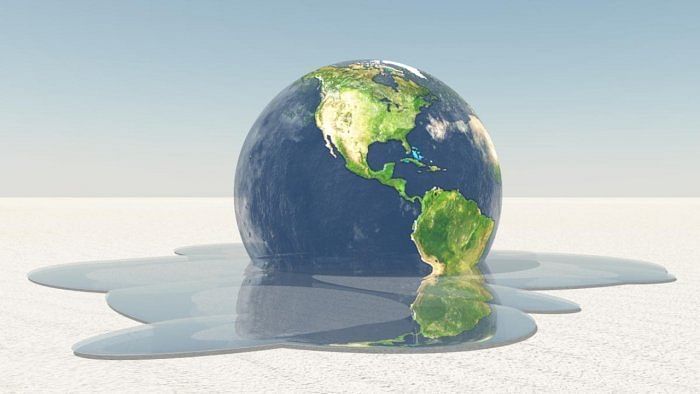
The mass media is awash with news on climate change, deforestation, the felling of trees for projects, and human-wildlife conflicts, with concerns being raised by naturalists, environmentalists, and editors. But the actions that lead to these catastrophes continue unabated. This, despite the fact that climate and biodiversity are complementary to the survival of man.
Climate change is a by-product of modern civilisation. The emission level of carbon dioxide is more than the tolerance level in the atmosphere. What was 0.02% in 1800 has increased to 0.04% in 2021, which is the real cause of global warming and climate change.
Global warming affects the seasonal regimes of climate, causing changes in summer (hot summers/heat waves), rainy season (heavy rains/cloudbursts/cyclones) and winter (too cold), thereby impacting the flora and fauna, and human beings.
Man, who is responsible for climate change, is also responsible for environmental pollution — by the emissions of carbon dioxide, dust and sound, by the release of sewage, chemicals and polythene. Climate change and pollution lead to the extinction of scores of microbiological components of the flora and fauna, threatening even bigger creatures — for example, the death of elephants in droughts, and whales in ocean pollution.
With all the powers gained through science and technology, human beings can withstand the ills of climate change and pollution. But the sufferers are the flora and fauna.
India had a robust wildlife population till the beginning of the 19th century, which took a hit when the Wildlife Protection Act, 1972 was enacted. The situation improved with the efforts of the Indian Board of Wildlife and Wildlife Act through projects for the conservation of tigers, lions, elephants, rhinoceros etc. Unfortunately, our forests are dwindling in quality and extent due to human pressure and the release of lands for cultivation under the Forest Rights Act, 2006. The forests are also dwindling in their carrying capacities due to invasive weeds and fires, which force wild animals to migrate in search of food, water, shelter and space.
When wild animals migrate for survival, the process causes damage to crops, lives and properties, thereby creating conflicts with humans and forcing governments to take measures to resolve them. They include various barriers built between wildlife habitats and human habitations like elephant-proof trenches, stone walls, solar fences, and old rail fences. In addition, wild animals are scared back into the forests or trapped and relocated to forests or rehabilitated in zoos, with compensation for human deaths, injuries, cattle deaths, and crop and property losses. But people near wildlife habitats are afraid to live close to the beasts; some indulge in the electrocution of animals, trapping/shooting of elephants, snaring, poisoning and killing of tigers, leopards, wild boars and bears against the law.
How do we tackle these new challenges in wildlife conservation? The answer by the government is to increase the budget allocation for resolving man-animal conflicts and compensation to the affected. But does it work? Quite doubtful. It might even lead to more suffering for wildlife and people.
The following remedies could be explored to resolve man-animal conflicts:
Stop further fragmentation of existing forests by cutting the long rope given to the Forest Rights Act; sympathy for tribals should not be at the cost of wildlife
Stop forest encroachments; don’t release forests to landgrabbers
Stop the release of forest lands for developmental projects. If inevitable, let the government acquire an equal extent of private land adjoining the forest and fund afforestation to ensure that wildlife habitats remain intact
Avoid highways, railways and waterways through protected areas. If it’s unavoidable, provide under- and over-passes to wild animals at regular intervals
Revise wildlife management strategies for habitats to ensure that invasive exotic weeds are uprooted and local grasses reappear
Ensure that wildlife habitats are free from summer fires by reducing inflammable dead wood debris so that even if a fire occurs, it is controllable
Manage the protected areas to have different stages of vegetation to meet the diverse food and shelter requirements of animals
Assess the carrying capacity of protected areas and adjoining forests. Plan to restrict animal population within capacity by modern means of population control if a region is isolated without corridors
The ideology of ‘living with wildlife’ will not suit the modern rural man even though the caveman and his successors lived along with wild animals in the forests for centuries
Farmers’ revolts during human-animal conflicts should not be allowed to turn into ‘human vs wildlife’
(The writer is a former
Indian Forest Service officer)